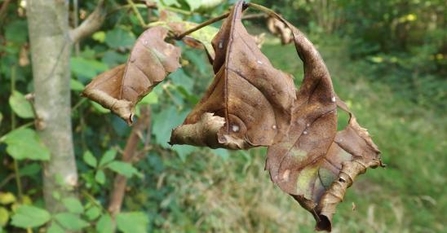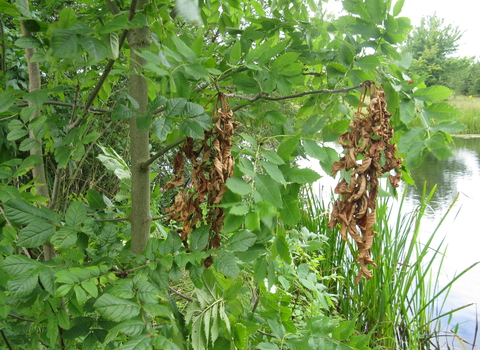What is ash dieback?
Ash dieback is a disease that affects ash trees, caused by a fungus called Hymenoscyphus fraxineus, believed to have origionated in Aisa. The first confirmed case appeared in the UK in 2012, since then it has spread across Wales. The fungus has two stages to its lifecycle - a sexual stage, which helps the fungus spread, and an asexual stage, which is what grows on the tree and causes damage. The fungus blocks water transport in the tree, leading to lesions in the bark, leaf loss and the dieback of the crown.
Ash dieback symptoms
The main symptoms of ash dieback are:
- Dead branches
- Blackening of leaves which often hang on the tree
- Discoloured stems often with a diamond-shape lesion where a leaf was attached
Trees may eventually drop limbs, collapse or fall. The symptoms are often easier to spot in mid-late summer when a healthy ash should be in full leaf. It becomes much harder in autumn when leaves are naturally changing colour and falling.
Once a tree is infected the disease is usually fatal, either directly, or indirectly by weakening the tree to the point where it succumbs more readily to attacks by other pests or pathogens, such as honey fungus. These secondary pathogens can cause butt or root rot, leading to the tree falling.
How does it spread?
The disease may spread locally (over tens of miles) by wind dispersal. The reproductive stage of the fungus grows on the previous year's fallen leaves, producing fruiting bodies that release spores between June and September. These spores are dispersed by the wind and settle on the leaves of healthy trees. If a healthy tree receives a high enough dose of spores, it too will become infected. Over longer distances, the disease may be spread by the movement of infected ash plants.
Management
There is no cure for ash dieback, but some trees are less susceptible to the disease. Investigating this natural resistance could be the best way to secure the future of Welsh ash trees. Some reserves and paths have been closed as a detailed assessment of the infected ash trees determined that making enough trees safe would cause too much harm to the nature reserves. There are many species that depends on ash and removing the trees would remove their habitat. It would also reduce our ability to learn about any resilience these local trees might have.
In some cases where trees grow beside roads and footpaths and are likely to pose a threat to public safety, they have been removed. The decision to close reserves and paths will be kept under review and updated on the reserve webpages if the situation changes.
What you can do
Biosecurity is important to help manage the spread of the disease. Simple steps such as washing your footwear before and after walking in woodland, sticking to footpaths and washing bike and car tyres can all help reduce the risk of spores being spread. Path closures are clearly marked on our sites and for your own safety we would ask that you respect the closures and instead continue to enjoy other routes available on site.

Infected ash leaf ©Steve Collin

